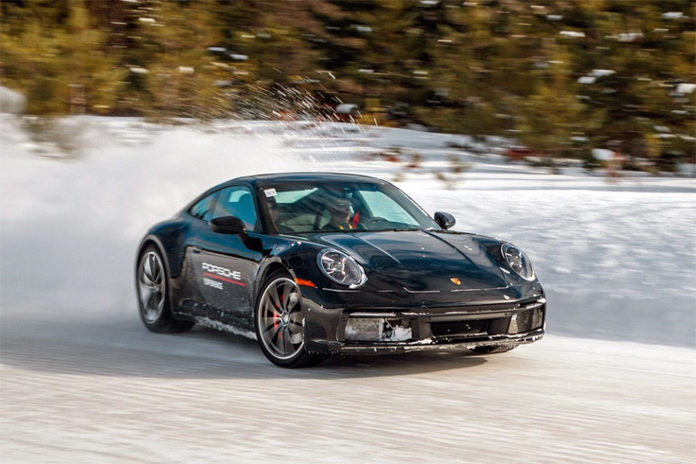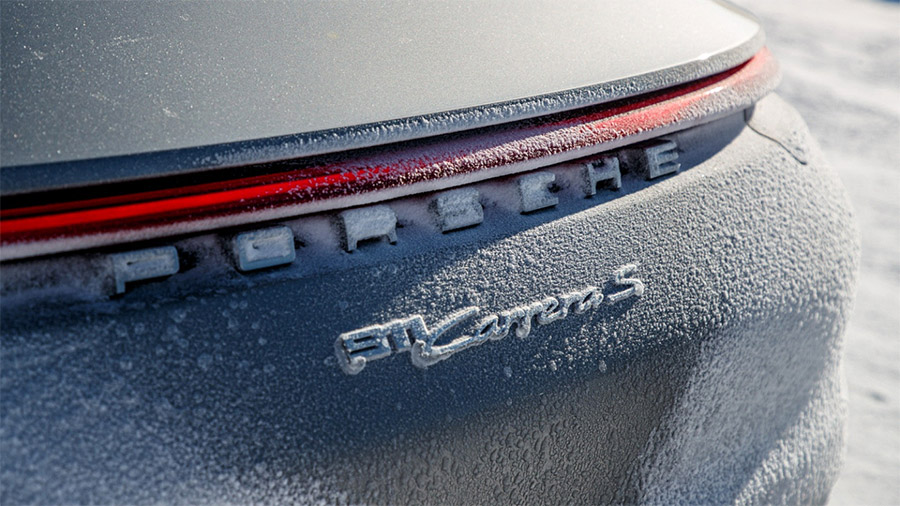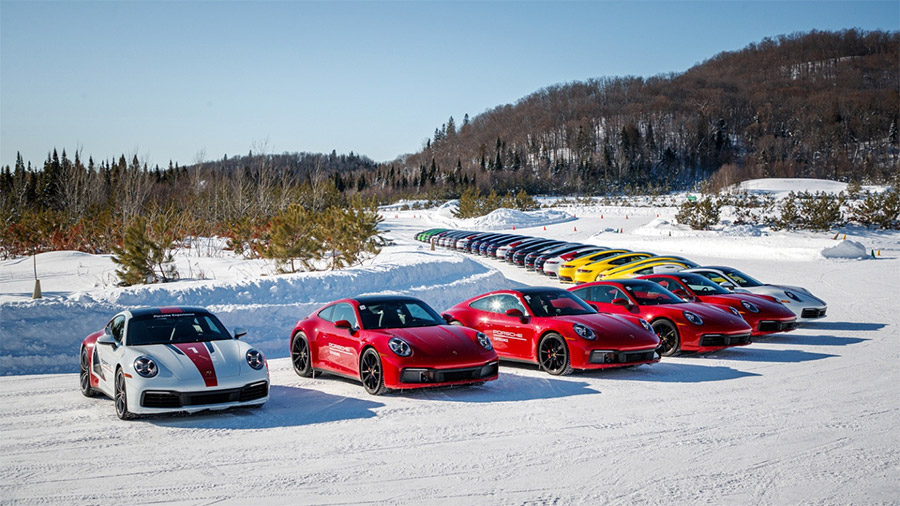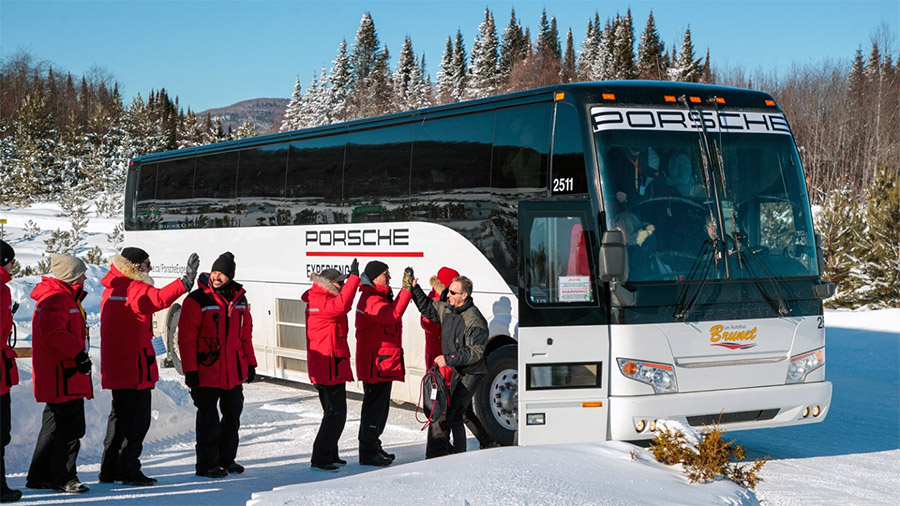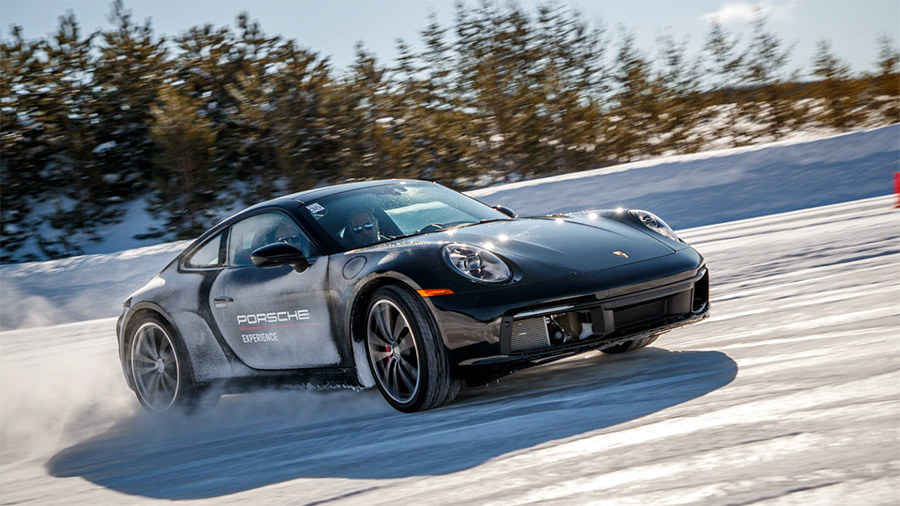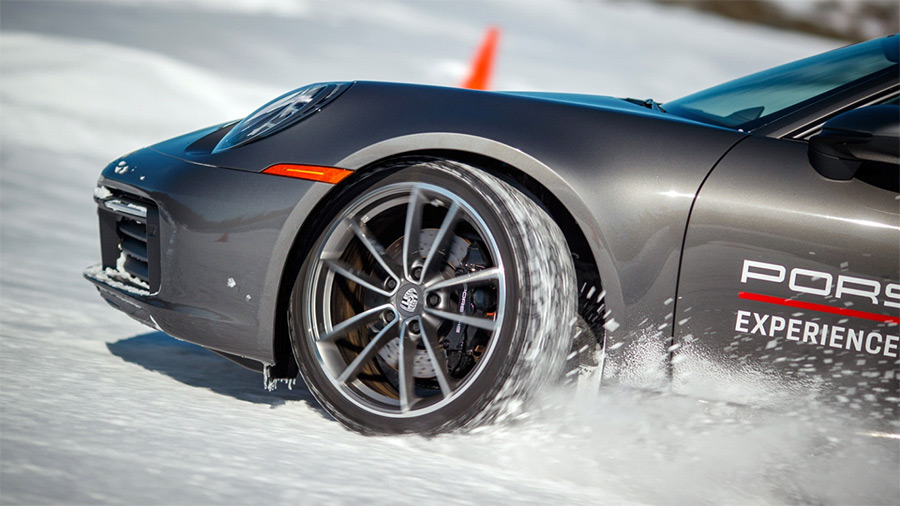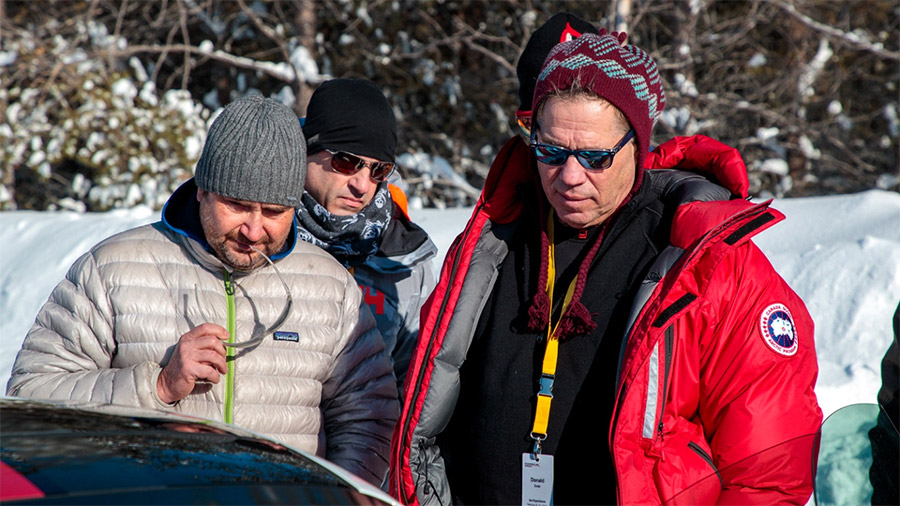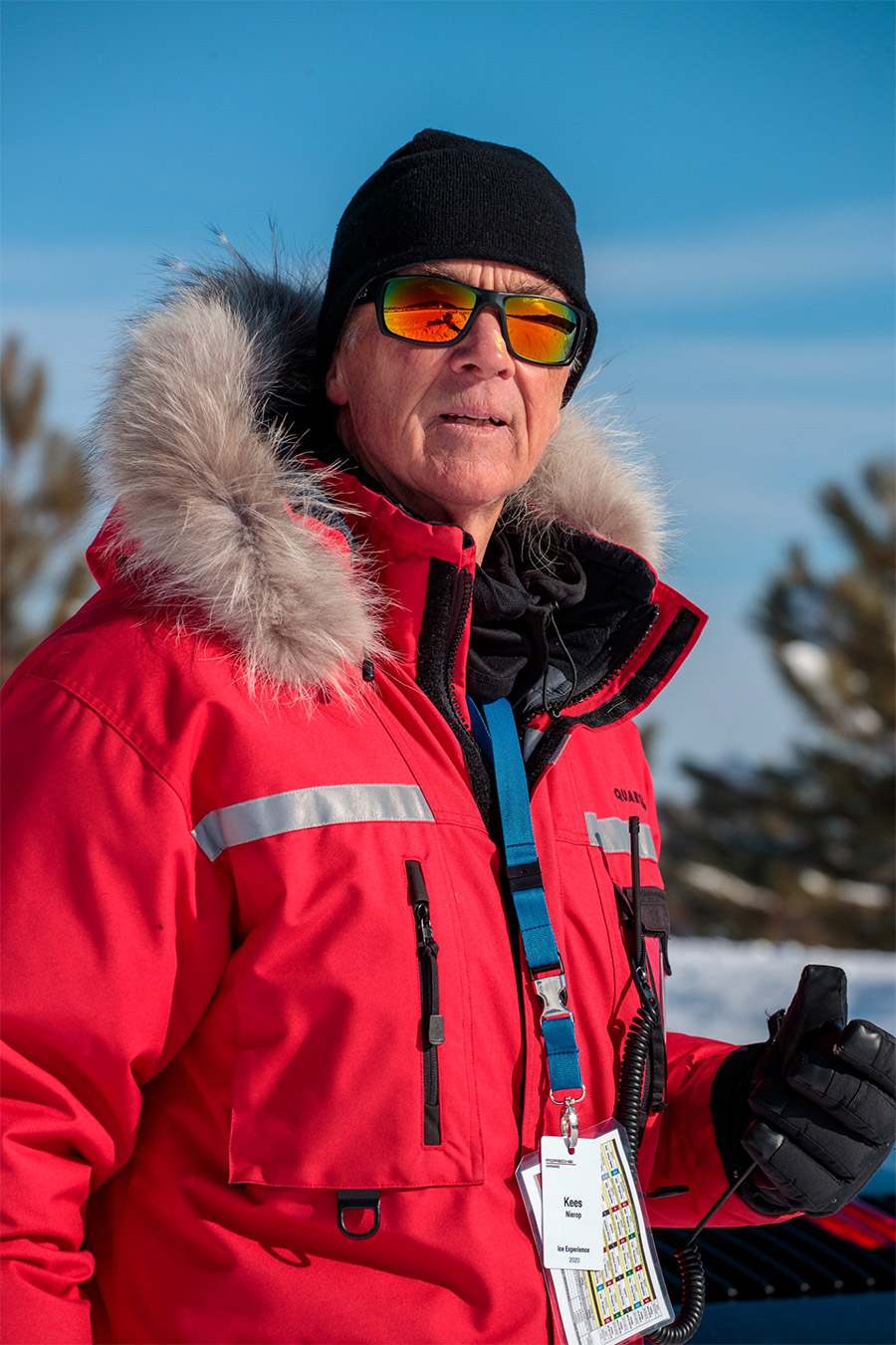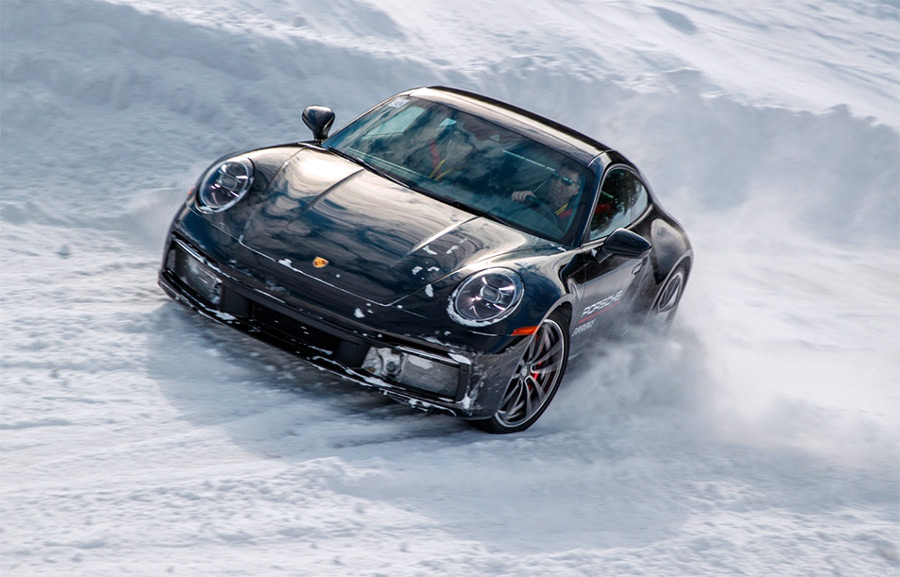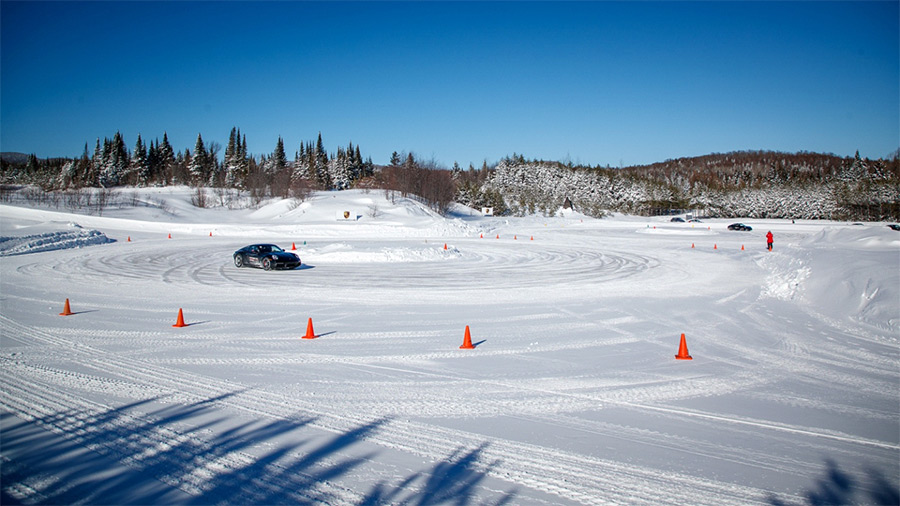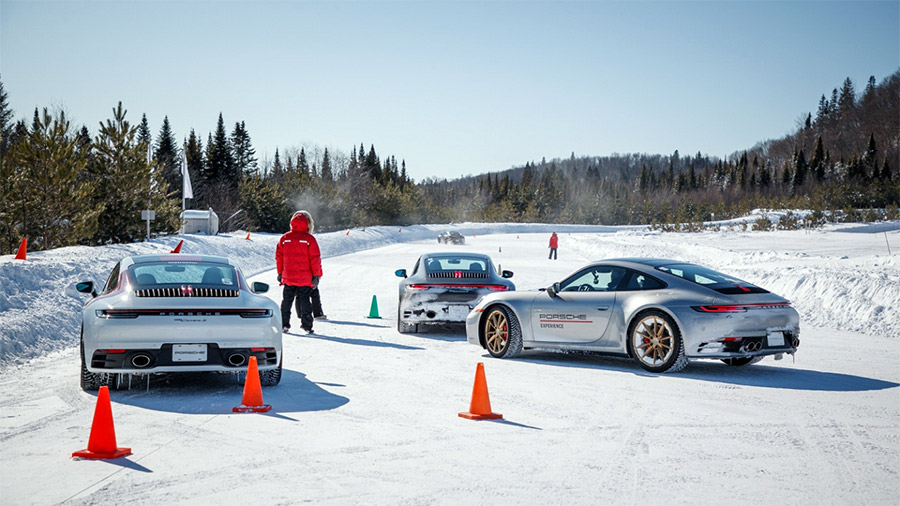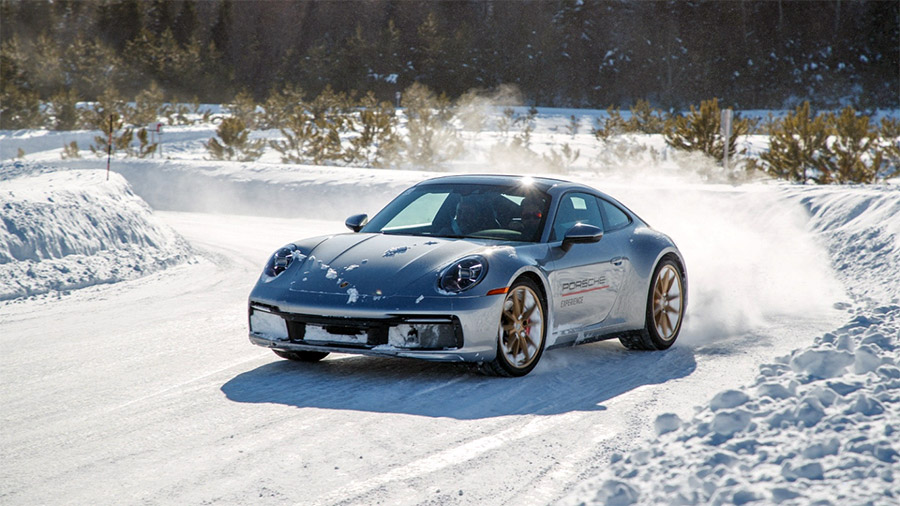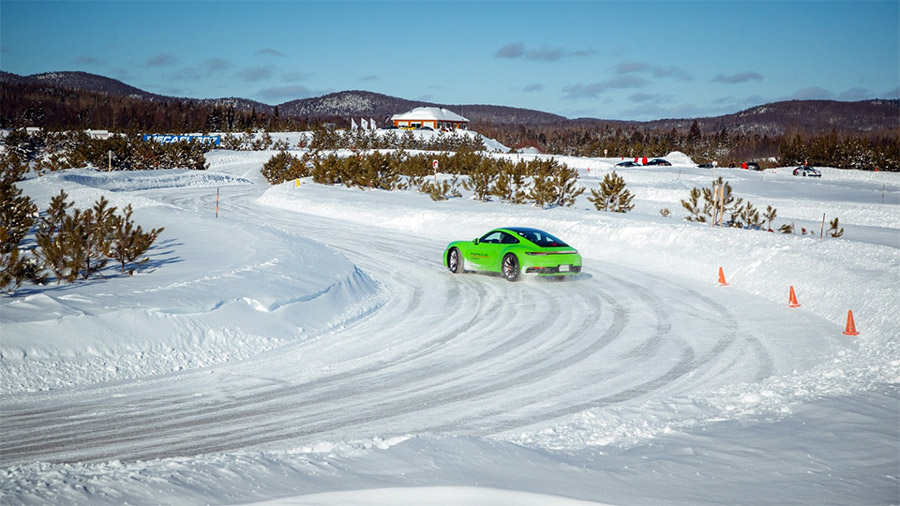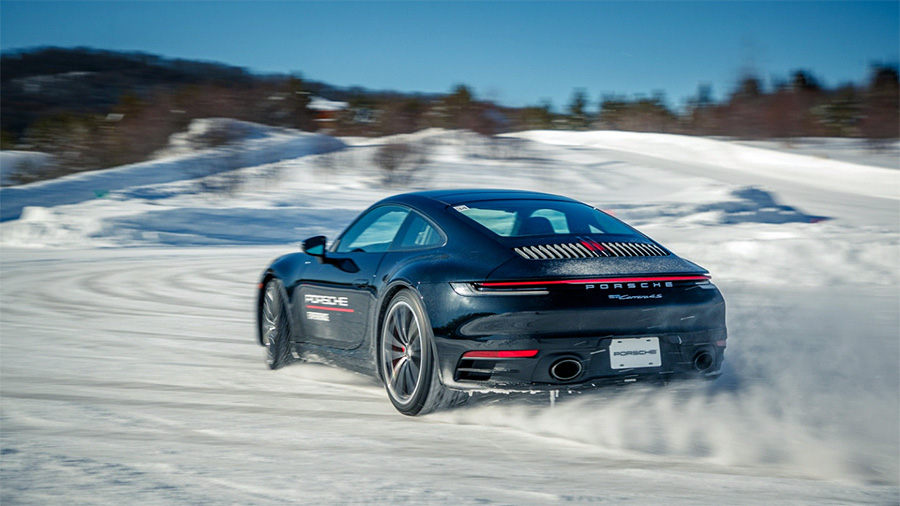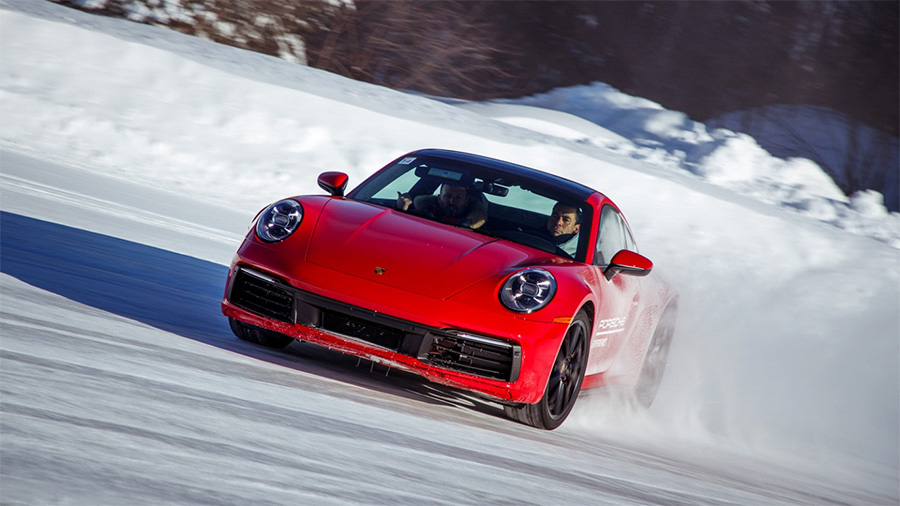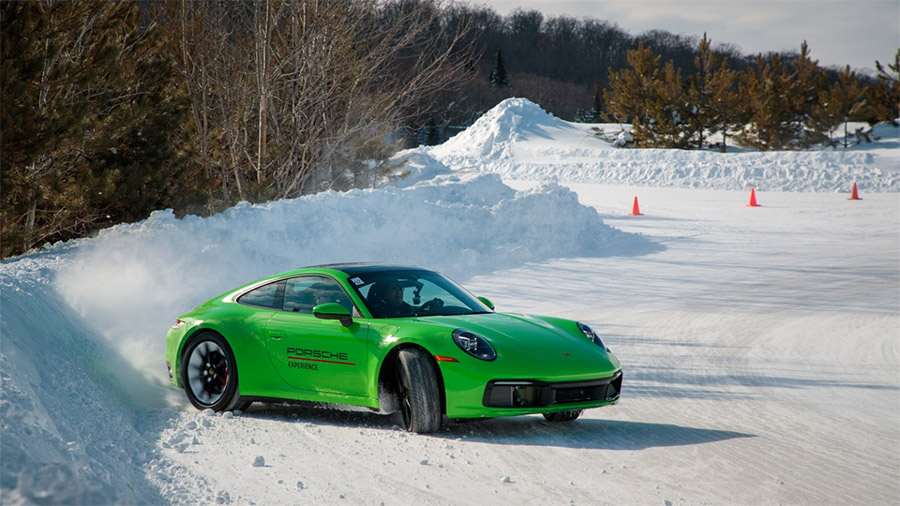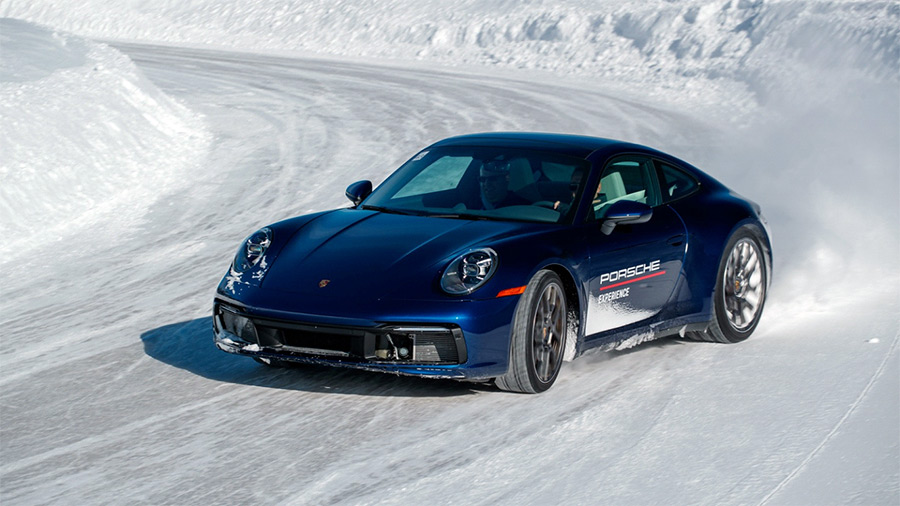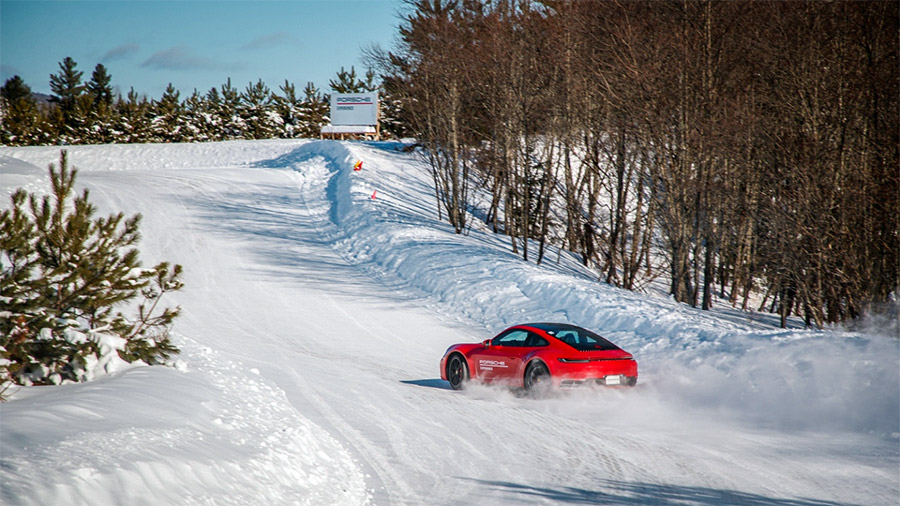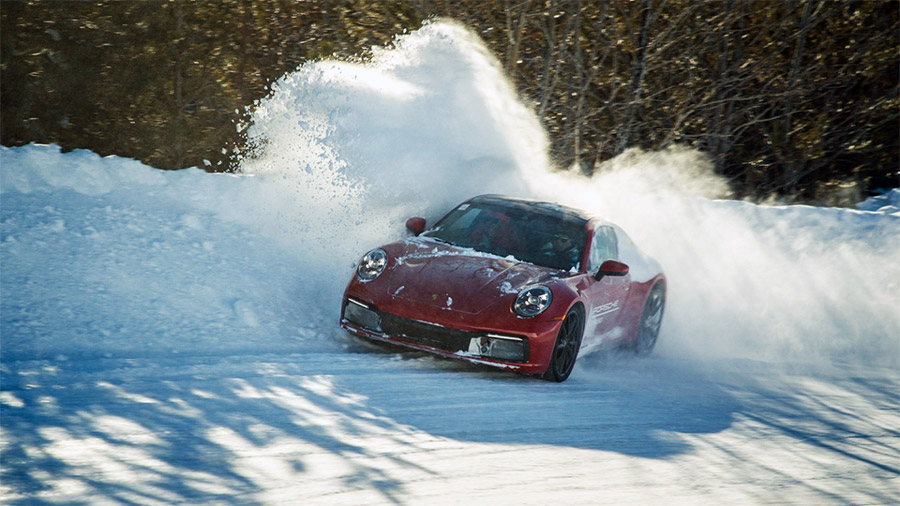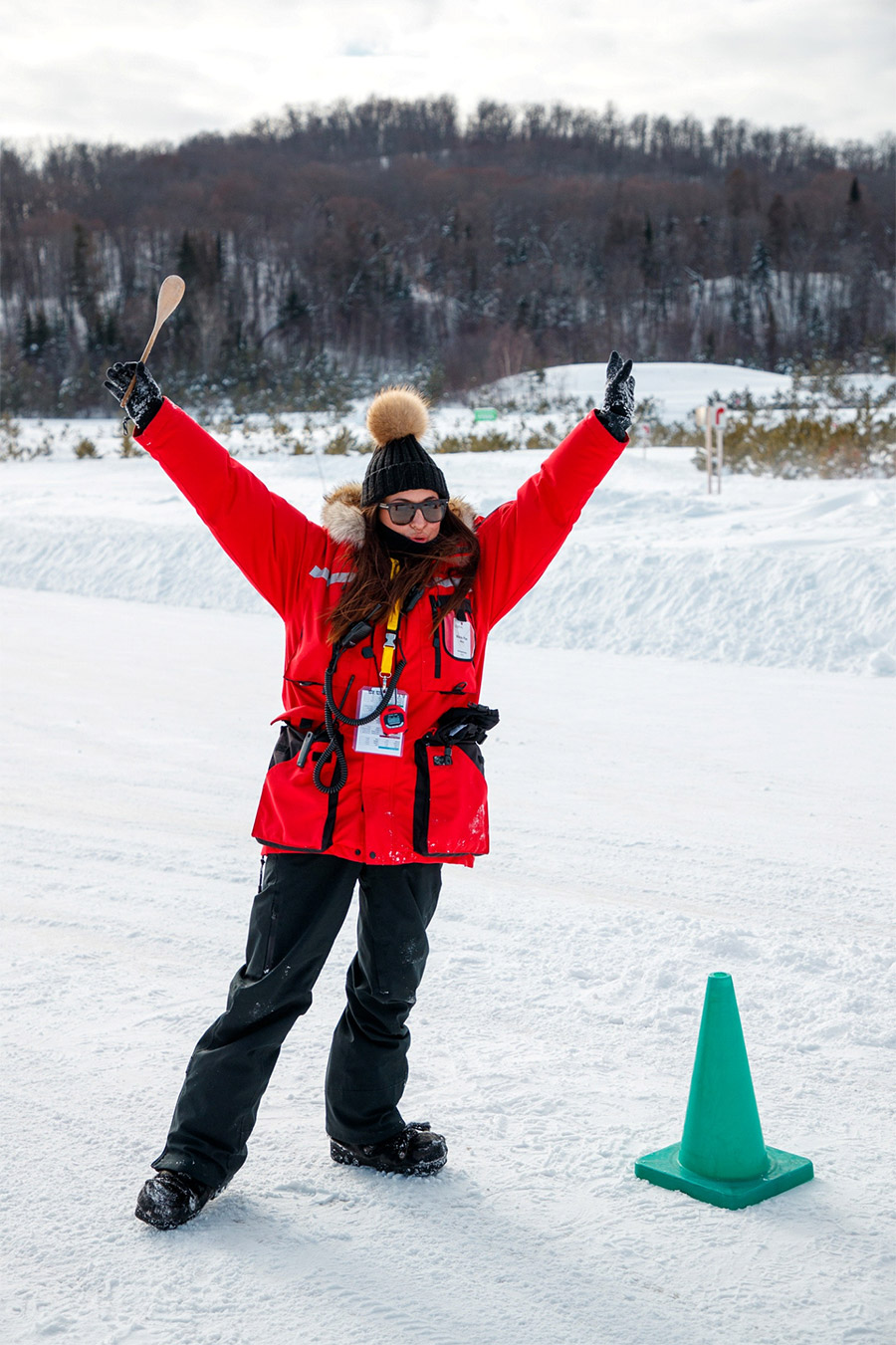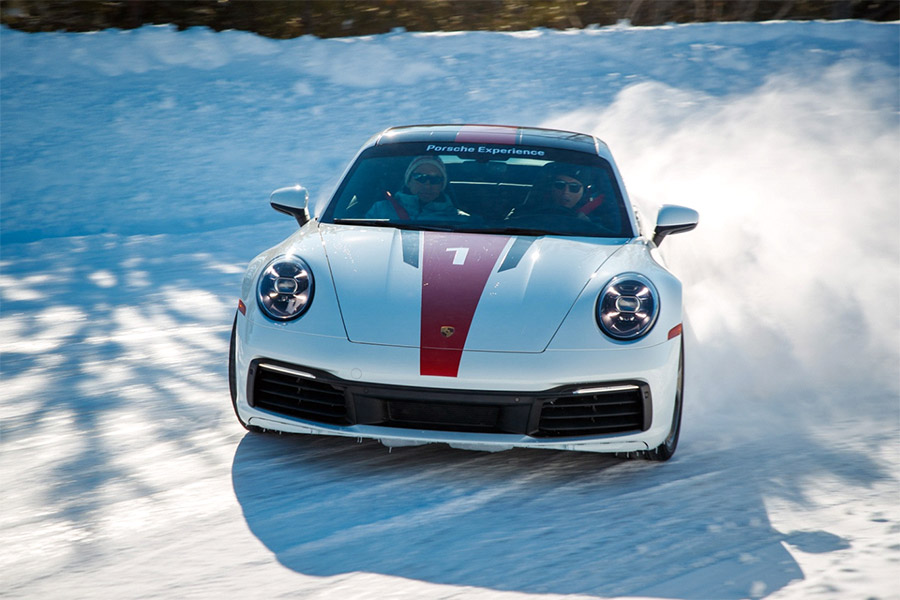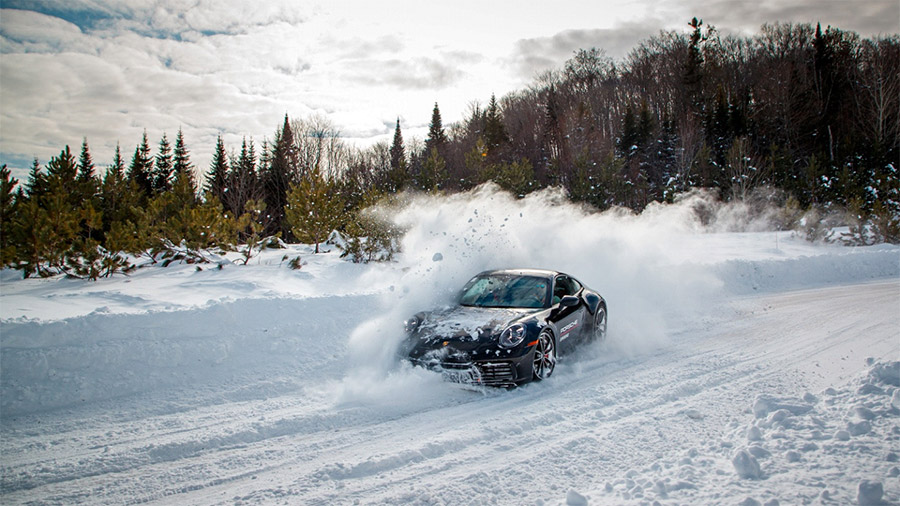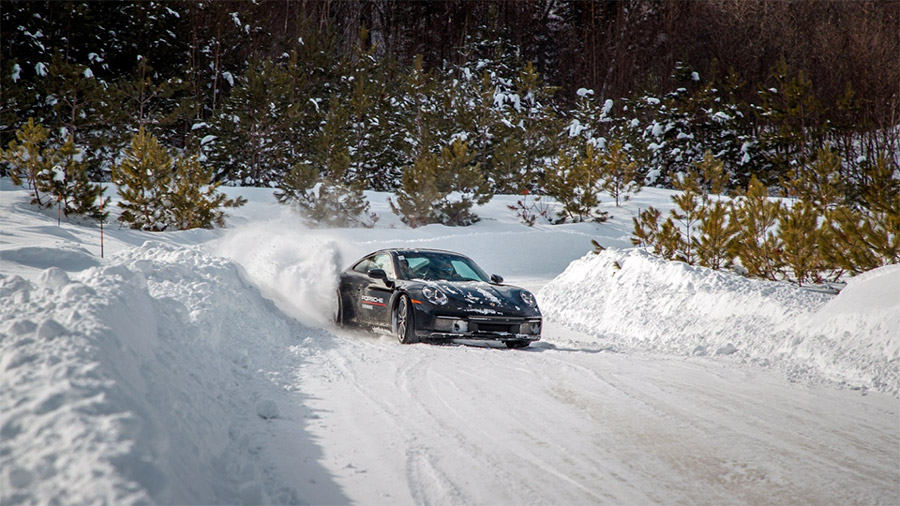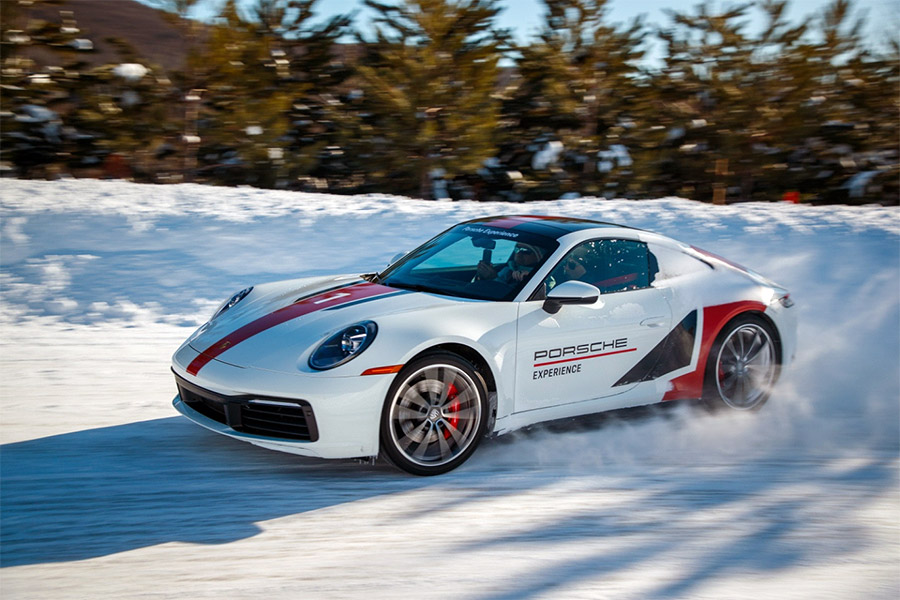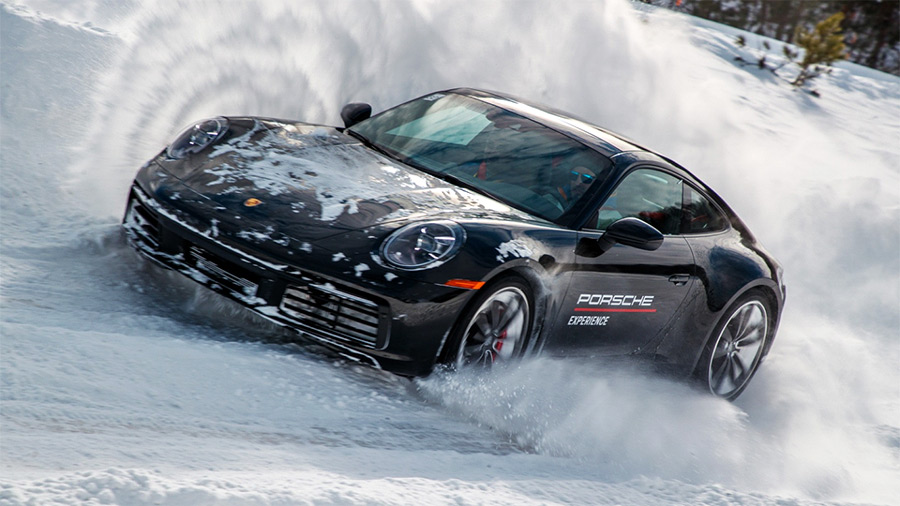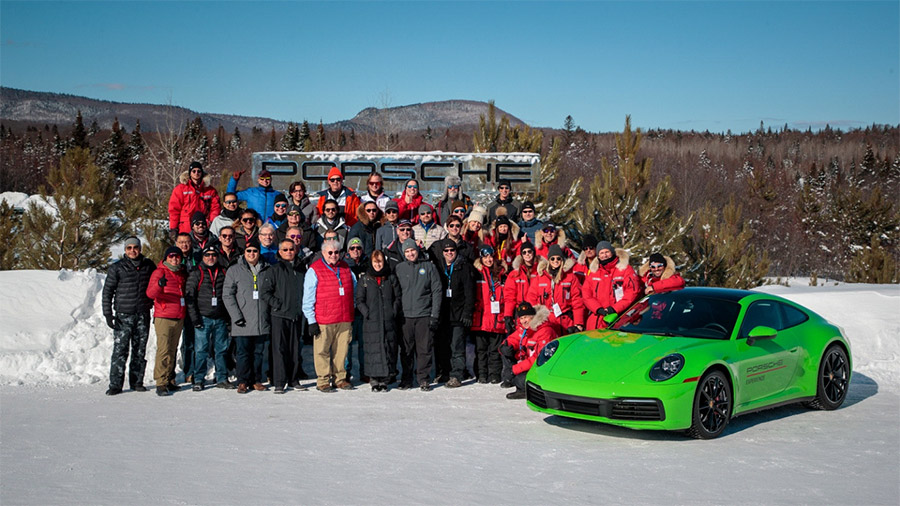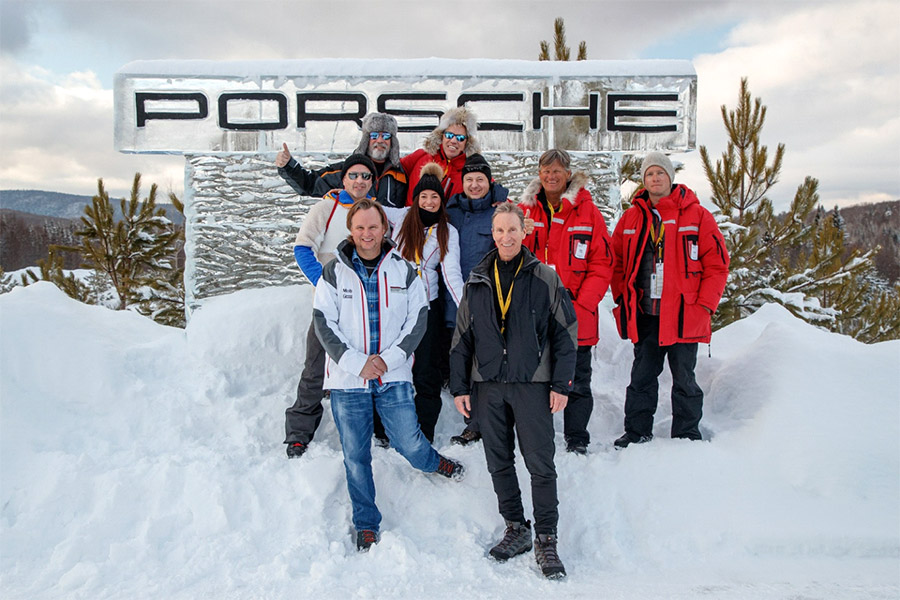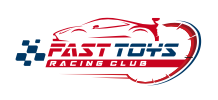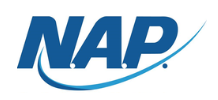A Porsche should not be a mere garage decoration nor a rare treat saved for a sunny day. Porsches are not intended to hibernate for the winter. They are meant to be driven – in all seasons.
After an hour and a half drive north of Montreal and deep into the heart of the Laurentian Mountains, one would almost expect to see “North Pole” signage. The nomadic sleighs that roam the countryside in these parts however are not from Santa’s garage but rather hail from the Porsche workshops in Germany.
The Porsche Ice Driving Experience addresses the question “Can a sportscar drive on the ice and snow?” The car is unquestionably capable, but the driver likely needs education and a little practice. Sliding Porsches around a private custom-built outdoor classroom for three days sounded like a lot of fun, which is why The Speed Journal sent its resident driver Jeff Francis to find out more.
Home base was the Estérel Resort. Guests typically strap on ice skates, snowshoes or cross-country skis, speed around the countryside on snowmobiles, or take refuge from the cold in the luxurious spa. Porsche guests enjoyed the lodging, but were also shuttled further north to the Circuit Mecaglisse for their own winter sports experience.
Circuit Mecaglisse specializes in sideways driving. The facility features 700 acres of various tracks and obstacles. In the warm weather months, rally schools run on dirt and gravel. When the cold weather comes, ice and snow packs on top of the dirt. The crew continuously works to carve pathways through the snowbanks and groom the icy surface to make an ideal base for sliding Porsches.
The key to the three-day course is car control – understanding vehicle dynamics, identifying signals the car sends to the driver, and smoothly adjusting to maintain momentum. Do it right, and a controlled sideways drift through a low grip corner will be the fastest way through.
The larger group broke into smaller groups based on experience and skills. Francis and a half dozen other guests with the benefit of prior Porsche driving experiences or ice driving experience clustered together. One Canadian and six Americans created a small group experience which was ideal.
After welcoming their guests, instructors got down to business and began explaining the nuances of vehicle dynamics, wright transfer and tire contact patches. They were experienced and knowledgeable and knew how to communicate the concepts in ways the guests could grasp and digest.
For example, while Francis and his new group became acquainted with their instructors, another group was being introduced to Kees Nierop. The Dutch-Canadian wheeled Porsches for over three decades, including factory drives at Daytona and LeMans. He has a Sebring win to his credit and famously drove the one and only 961, the circuit racing version of the 959 supercar, at LeMans. For the past twelve years Nierop has been one of the Porsche driving instructors. That’s the kind of knowledge on site for the Porsche ice driving experience.
The ice driving coaches had learned a few things of their own. They described driving smoothness as similar to the challenge of holding a box of water. Move suddenly and the water will splash and spill. Move smoothly and the water moves with you but stays in the box. The instructors credited Nierop with the analogy.
The instructors also acknowledged the built-in understeer that Porsches typically have direct from the factory. A touch of understeer may be helpful to prevent drivers from getting themselves into trouble, but rally skills can overcome and manage that bias. They spent a bit of time cautioning drivers to be aware of surface changes, as snow and ice change more than a static asphalt surface. With multiple exercises spread over three days of driving, there was sure to be an evolution in the coating of ice and snow.
The trusty Porsche 911 served as the school car. The 911 has evolved over the years through multiple models, including the 964, 993, 996, 997 and 991 but the school was stocked with the newest iteration, the 992. Both two-wheel drive and four-wheel drive versions were on hand and all were fitted with studded tires to aid in the cause of traction. Unsurprisingly, the group would find that there was a marked difference between the two and four wheel drive Carreras. The ice experience was the perfect venue to try out both.
After the program preview and chalk talk in the warmth of the Mecaglisse club house, the group moved behind the wheel of the Carrera 4S on two large round skid pads surfaced with ice and snow. Drivers experimented on the first skid pad by heading straight for an instructor and turning hard to make the front wheels understeer. With the slide underway, drivers learned to feather off the throttle, apply steering corrections, and drive away. On the flip side of the handling coin, students threw the rear end around with oversteer, corrected and used the four wheel drive to pull out of the slide.
This served as a warm-up for the second skid pad where the group was let loose to run and experiment on their own. The elusive gold standard was a consistent sideways drift through a full orbit around the center. A steady drift around the outside of the circle sprayed snow behind the cars which made for a compelling visual – but students also learned to feel the surface difference beneath the tires. Four wheels clawing for traction on the ice could save a slide that might have otherwise seen the rear swap ends with the front.
Each driver made several runs, periodically switching out to let another driver give it a try, and then resuming the process. At this point instructors prioritized seat time, and focused less on the educational aspect.
The next exercise required that the group move to the two-wheel Carrera S for a slalom exercise. Five cones sound simple, but the cones were staggered and large snow drifts loomed on each side. Drivers drifted around and through the cones, slid through an off-camber hairpin to reverse direction, and returned back through the cones to the start/finish line. The pendulum effect of throwing the car back and forth through the offset cones highlighted the weight transfer and put a premium on smoothness.
After a welcome break for lunch, the participants were introduced to a short road course with elevation changes, which would make things even more interesting. Drivers started a lap by pushing their Carrera S mounts through a long left-hand sweeper. On the first day, Francis kept the car in second gear to maintain the slide and avoid the nearby snowbanks. When revisiting the same sweeper later in the event, he would bump up into third gear and carry more speed. But for now, his focus was on piecing together shorter drifts, reading the elevation changes, and feathering the throttle to wag the Porsche’s tail just enough to slide but not spin.
After practicing car control on the road course, the group shifted to the Carrera 4S to look at sliding through a more scientific lens. As might be expected, Porsche and the instructors had done their homework and determined the technically correct way to initiate a slide. While one’s instinct might be to mash the throttle to get the tail to swing, the physics of car control and weight transfer point more to the brake than the throttle. Instructors were adamant about this, referencing lessons learned from decades of rally driving on slippery surfaces. Students practiced by driving straight ahead at about 35 miles per hour, lifting, turning and braking. It is more difficult to rely on the brake but makes a nimbler dance through a corner. After a few runs, students were encouraged to try left foot braking to make the required footwork smoother.
By this point in the day, the accumulated snow had cleared and the cars were skipping across a hard-packed icy surface. Instructors demonstrated by drive lead, with students maneuvering close behind. Instructors also periodically jumped into student cars, either as drivers or passengers for more personal instruction. Of course, the brake lights don’t lie, so instructors watched from the sidelines where they could easily see who used the brake and who fell back to rely on the throttle.
The group later retreated to the Estérel Resort to enjoy a delicious dinner, hospitality, and a bit of bench racing. It was a busy day, so there was plenty to talk about.
The second day followed the path established in the first day – complete with a starting temperature of 37 degrees below zero Fahrenheit! Students generally remained tucked into the cars, emerging briefly to change and participate in debriefings. Instructors, however, bundled up and braved the cold.
The morning began by using the Carrera S to learn the rally flick – the technique of steering towards the outside of the turn to create oversteer, slightly touching the brakes to move the car’s weight, and then apply steering and throttle to control the slide through the corner. Sometimes called a “pendulum turn” because of the weight transfer, the technique is attributed to Scandinavian rally drivers who perfected their craft through icy forest rally stages. The corner for the exercise had a downward slope that further challenged the pilots, and was followed by a brief slalom at corner exit to emphasize continued control as the car pitched from side to side.
This skill takes time and diligence to master. Spins were common. The surface also changed over time, so adapting to conditions was critical. For the most part, cars stayed out of the snowy berms around the perimeter but a Cayenne leapt into action when needed to pull stranded cars to safety.
After students and instructors refueled with lunch, the instructors made things more interesting. They linked parts of the Mecaglisse circuit together to create rally stages – twists to the left and right, elevation changes up and down, corners with helpful camber, other corners that sloped away from the apex, surface changes, and snow banks that were either generous or threatening.
Students sliced through the course, bouncing off the snow banked walls at times. If a snow bank grabbed a bite of either the front or rear tire, it sucked the entire car off line and produced a telltale spray of snow. Most often, students could extract themselves and continue, but snowy remnants remained on the bodywork, windshields and any opening snow could fill when they returned to the start/finish line. Instructors employed large wooden spoons to clean out the snow and students quickly went on their way for another attempt. While the snow banks might have captured cars, they did no damage (except perhaps briefly to the driver’s sense of pride). The cars were amazingly resilient and eventually the drivers spent less time in the snow banks as they gained comfort in their four-wheel drive Carreras.
Students moved to revisit the exercise of the first morning of maintaining a sideways drive while going around in a circle. Rather than revisiting the same skidpad used on the first day, the group moved to a different large circular skid pad located elsewhere on the grounds. Armed with more experience, knowledge, and skill, the group set to the task eagerly. The circle was sloped at one side which could be used as an advantage to transfer weight. Deftly working the brake, steering and throttle, the students experimented with tight circles and wide sweeping circles. They tested their cars on different surface areas to sense the variations in the car’s reaction. Areas with a layer of snow offered traction whereas hard packed ice without any snow offered little grip. Instructor Curtis Fox set up in the middle of the giant circle and provided instant feedback to drivers via two-way radio.
After two days of switching between two and four wheel drive Carreras, the unique character of each vehicle became more evident. In contrast to the rear wheel drive model, the four-wheel drive system seemed to sense when assistance was required and moved drive towards the front wheels electronically to help pull the car out of a slide or spin.
To cap off the day, a Porsche bannered bus took students and instructors to a quaint rustic restaurant where they were served local natural dishes. It was the perfect representation of the remote Canadian area surrounding the Estérel Resort and Circuit Mecaglisse combined with a touch of Porsche sophistication.
A Porsche driving program in the snow and ice isn’t as unusual as it might sound. Part of that evening’s discussion revolved around the marque’s history. In early 1982, when Porsche was evaluating and testing four-wheel drive technology, engineers headed to the wintry Austrian Alps. Subsequently in 1986, the Paris-Dakar rally took competitors through the snow on at least one stage, with the 959 claiming overall victory. The 959 tested on the snow and proved the technology could work for the road. Since the 1990 model year with the 964, the 911 family has consistently included four-wheel drive models.
The bright sunshine of the first two days gave way to snow flurries when the group awoke to the third and final day. The snow added visual interest to the already dramatic environment. The morning was spent conducting various exercises – lift, turn, brake, steer, patiently apply throttle, repeat. Running different corners, different configurations and even running some corners in reverse provided different ways to apply and develop the skill. Patience was required to let the car slide and then apply inputs in the right measure at the right time. The key theme was car control, to manage the weight and momentum of the machine. Switching to the Carrera 2 again highlighted the different driving techniques required with and without the benefit of front wheels pulling the car forward.
Eager to drive, students were released after lunch for open lapping on the simulated rally course. No exercises, no lessons, no structure other than uninterrupted runs, switch drivers for a breather, and then try it all again. The rally stage linked several different courses around the facility and combined the best and most varied lines to maximize the sensations and challenges. Except for jumps, the course encompassed everything a real rally course would – ascents and descents, negative and positive cambered turns, tight and wide corners, and surface variations. It drew on every skill the students had learned and offered little margin for error. As always, the snow banks threatened to ensnare those who overstepped the boundaries but the cost for getting it wrong was measured in time and pride rather than damaged bodywork. If there was a time to test the limits and experiment with newfound skills, this was it.
The open lapping was absolutely exhilarating. It was the best part of the three days and made sense of all the two plus days’ worth of exercises done in preparation. For road racers more familiar with searching for grip, charting ideal lines, and avoiding slipping and sliding, it was a very unique and enjoyable outing.
Before attending the ice driving experience, the mind envisions wide open flat frozen lake type environments. After getting the chance to run on courses with elevation changes, it would be difficult to imagine that a flat track could challenge for novelty and interest.
The driving activities of the day concluded with a timed figure eight competition. The course was laid out over a gradual downhill at the bottom where it was slickest. Students were challenged to determine the best lines. An outside line might maintain momentum and use snowy powder for traction but require a much longer distance to make the turn and risk getting sucked into the snow bank. A tight inside line would minimize the distance, but risk spinning on the packed ice without a gentle tip toe approach. In either case, drivers accelerated and fish tailed up the hill as they found improved grip and climbed up the slope to the finish. The instructors timed the laps and presented a prize to the winner at a farewell dinner.
The dinner celebration included awards, recounting stories from the prior three days, and a large measure of laughter. A perfect way to end the event and send everyone home with a great story to tell. Despite the sub-zero temps and ice and snow, no sightings of reindeer or penguins were reported. Whether there to improve winter driving skills or just having fun rally driving Porsches across the ice and snow, everyone left the program armed with stronger driving skills than when they arrived just a few days earlier.
The Porsche Ice Driving Experience was easily a driving highlight. The facility is amazing, the instructors very capable and effective, the cars themselves were top notch and well prepared, the lodging and food were both outstanding, and somehow it all comes at a price that makes it a value. It’s highly recommended for those who can organize their calendar accordingly, combining the Porsche Ice Driving Experience with a few days in nearby Montreal will make for a memorable destination experience.


